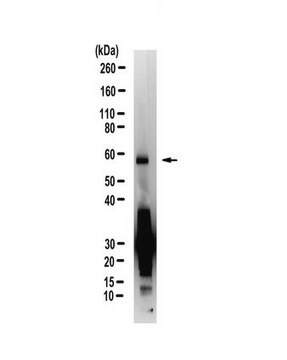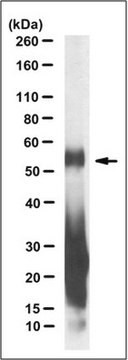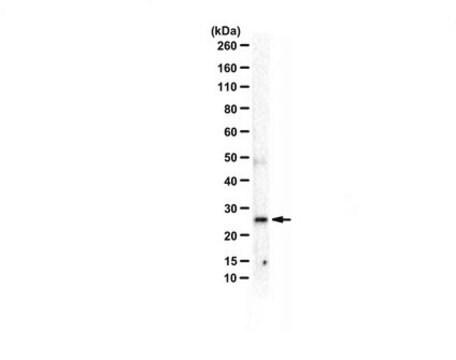ABN1360
Przeciwciało anty-C9ORF72 (sens α-GR, CT)
serum, from rabbit
Synonim(y):
C9orf72/C9RANT (GR sense-CT), alpha-GR-CT-sense, alpha-GR-CT, Protoein Protein C9orf72-GR-CT
About This Item
Polecane produkty
pochodzenie biologiczne
rabbit
Poziom jakości
forma przeciwciała
serum
rodzaj przeciwciała
primary antibodies
klon
polyclonal
reaktywność gatunkowa
human
opakowanie
antibody small pack of 25 μL
metody
dot blot: suitable
immunocytochemistry: suitable
immunofluorescence: suitable
immunohistochemistry: suitable
western blot: suitable
izotyp
IgG
numer dostępu NCBI
numer dostępu UniProt
Warunki transportu
ambient
docelowa modyfikacja potranslacyjna
unmodified
informacje o genach
human ... C9orf72(203228)
Powiązane kategorie
Opis ogólny
Specyficzność
Immunogen
Zastosowanie
Analiza immunohistochemiczna: Reprezentatywna partia wykryła C9ORF72 (alfa-GR sens, CT) w agregatach znalezionych w neuronach regionów CA i DG hipokampa (Zu, T., et. al. (2013). Proc Natl Acad Sci USA. 110(51):E4968-77).
Analiza immunocytochemiczna: Rozcieńczenie 1:500 z reprezentatywnej partii wykryło C9ORF72 (alfa-GR sens, CT) w V5-GR-Ct transfekowanym HEK293 (dzięki uprzejmości dr Laury P.W. Ranum i dr Lien Nguyen z University of Florida).
Analiza Dot Blot: Reprezentatywna partia wykryła C9ORF72 (alfa-GR sens, CT) w Dot blotach zawierających lizaty kory czołowej od różnych C9(-) i różnych C9(+) pacjentów z ALS/otępieniem czołowo-skroniowym (FTD) (Zu, T., et. al. (2013). Proc Natl Acad Sci USA. 110(51):E4968-77).
Analiza Western Blotting: Reprezentatywna partia wykryła C9ORF72 (alfa-GR sens, CT) w aplikacjach Western Blotting (Zu, T., et. al. (2013). Proc Natl Acad Sci USA. 110(51):E4968-77).
Neuroscience
Jakość
Western Blotting Analysis: A 1:1,000 dilution of this antibody detected C9ORF72 (alpha-GR sense, CT) in V5-GR-CT transfected HEK293 cell lysate.
Opis wartości docelowych
Postać fizyczna
Przechowywanie i stabilność
Inne uwagi
Oświadczenie o zrzeczeniu się odpowiedzialności
Nie możesz znaleźć właściwego produktu?
Wypróbuj nasz Narzędzie selektora produktów.
Kod klasy składowania
12 - Non Combustible Liquids
Klasa zagrożenia wodnego (WGK)
WGK 1
Temperatura zapłonu (°F)
Not applicable
Temperatura zapłonu (°C)
Not applicable
Certyfikaty analizy (CoA)
Poszukaj Certyfikaty analizy (CoA), wpisując numer partii/serii produktów. Numery serii i partii można znaleźć na etykiecie produktu po słowach „seria” lub „partia”.
Masz już ten produkt?
Dokumenty związane z niedawno zakupionymi produktami zostały zamieszczone w Bibliotece dokumentów.
Nasz zespół naukowców ma doświadczenie we wszystkich obszarach badań, w tym w naukach przyrodniczych, materiałoznawstwie, syntezie chemicznej, chromatografii, analityce i wielu innych dziedzinach.
Skontaktuj się z zespołem ds. pomocy technicznej








